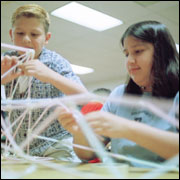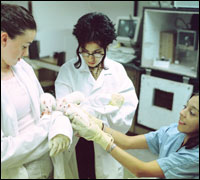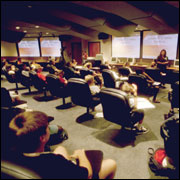|
Happy Campers
Summer youth programs make learning fun for
hundreds of young students
by Sherry Wodraska Neaves

Gateway to Engineering participants Jonathan Taylor, left, and
George Apecechea offer assistance as Robert Fetterman performs a
remote-controlled simulation of the Mars Rover landing on the Library
Mall.
Come summer, the University student body shrinks
dramatically. It’s not just that the number of students decreases—the
students really are shorter, and younger.
When hot weather hit a few months ago, UTA became a campus full
of campers, as it does every summer. From first-graders to high
school seniors, hundreds of young students come to science, music,
engineering and athletic camps. Still others come to take courses
for college credit in the Honors Academy.
From the time she was 12, Heather Dunn honed her
skills at UTA’s summer volleyball camp. In high school she
anchored an Arlington High team that routinely made the playoffs
and last year reached the Class 5A regional semifinals. This season,
Heather, once called the “quarterback of Arlington’s offense”
by the Fort Worth Star-Telegram, will begin her career as a Lady
Maverick.
“I came to the camps every year. I got to know the coaches
and learn their styles,” she said. “They talked with me,
worked with me and helped me improve. I really liked it here and
didn’t want to leave. So I signed with UTA.”
Dunn’s not the only one to make the transition from camper
to campus. As a high school senior, Brett Ragon attended 1999’s
inaugural session of the Summer Science Institute. Today he’s
a chemistry sophomore and newly elected president of the Chemistry
and Biochemistry Society.
Eleven participants from that first science institute are now enrolled
at UTA.
“So many of these kids never even
thought about coming to UTA,” institute director Lori
Norris said. “We’re just part of their own back
yard. But when they come here and get a look behind the
scenes, they get really fired up about science and about
the University.”
More than 90 students participated in
this year’s four-week institute, going to class from
9 a.m. to 1 p.m. Monday-Thursday. Kenny Gustafson, 13, and
Amanda Hearn, 16, taught rats to walk backward in their
experimental psychology section.
|
 |

As part of the Summer Science Institute's
TexPREP Math course, Tony Alvarez and Cynthia Cardenas build
a bridge out of straws. The exercise teaches the junior high
students practical applications of logic and algebra. |
“It’s interesting that they [the rats]
can get so motivated to do things they normally wouldn’t do,”
Amanda said.
“It’s really cool,” Kenny added. “We learn how
the mind works through training rats. It’s better than sitting
in class.”
Hands-on approach
Sitting in class is an anathema for Norris
and College of Science Dean Neal Smatresk. From the day he became
dean, Dr. Smatresk has focused on building children’s innate
fascination with science.

From left: Jessica Lommel, Magali Batteras
and Mary Riojas take a break from training their rats during
a summer course in experimental psychology.
|
 |
“We all need to work hard to maintain
that interest they have when they’re young,” he
said. “Here they can express their love of science. They
get hands-on experience they can later translate into their
classes in high school and college.”
“It has to be fun,” Norris said. “The reason
a lot of kids get bored with science is that they don’t
do much hands-on work. Here they use the DNA sequencer and
the electron microscopes; they run the planetarium. They’re
having so much fun, they don’t realize they’ve learned
so much.”
|
Summer camp instructors are carefully selected.
“We want people who relate to kids,” Norris said. “They
always love hearing about biology Professor Jonathan Campbell and
his travel adventures. He’s been held at gunpoint on three
continents.
“It’s important for the kids to see that scientists aren’t
just dried-up old men in cramped back rooms. These are young, cool
instructors who show the kids that scientists are not geeks. Biology
Lecturer Timothy Henry plays the harmonica and writes songs for
them. He’s even been known to do a few back flips.”
Enthusiasm reigns at all the summer youth programs. Robert Qualls
was so eager to attend his third strings camp that he was the second
bass player to sign up. More than 400 students annually attend the
camp for junior high and high school violin, viola, cello and bass
performers. Through auditions, they are placed in one of six orchestras
and present a full concert on the camp’s closing night.
“It’s kind of amazing what they accomplish in just a week,”
said camp co-director Sylvia Coatney. “There’s a big difference
from hearing them on Monday as they sight read through the music,
to sitting in the audience on Friday night.”
Cello devotees had their own special camp this summer, the Texas
Cello Academy. Students in the 32-member debut class ranged from
sixth-graders to teachers who, like academy director and music Associate
Professor Elizabeth Morrow, have played for most of their lives.
The UTA Music Department also offered summer camps in concert band,
brass chamber music, jazz improvisation and marching band. Not only
do the camps bring prospective students to UTA, they also provide
scholarship funding for current student musicians. The strings camp
alone generates about $10,000 annually for scholarship programs.
Adventures in engineering
The College of Engineering opens a Gateway
to Engineering and builds a Bridge to Engineering during its summer
programs. The Gateway camp, for seventh- and eighth-graders, and
the Bridge program, for high school freshmen and sophomores, bring
150 students to campus, 50 at a time, for a week-long adventure
in engineering.
In earlier incarnations, the engineering
camps targeted high school juniors and seniors, but directors
soon discovered that by then students had already decided
what to study in college.
“We realized that if we were going to make changes
in anybody’s minds, we had to get them started a lot
earlier,” engineering Associate Dean Lynn Peterson
said. “Then we looked at it some more and decided to
move to a residential program. We thought it might all work
better if parents didn’t have to drop off and pick
up their students every day.”
|
 |

Bridge to Engineering students took a field
trip to Verizon Communications, where they learned about broadband
and wireless technology. |
Seems to be working fine. Many students who complete the Gateway program
come back to cross the Bridge. Much like the
science institute, both engineering offerings emphasize participation
over lecture. Every student is part of a small team project, and all
the projects are presented at week’s end. The students might
dabble with robotics or fashion solar-powered rockets.
Those kinds of projects add the final—and most important—ingredient,
the element that brings campers like Heather Dunn and Robert Qualls
back year after year after year.
UTA summer camps are just plain fun!
|

